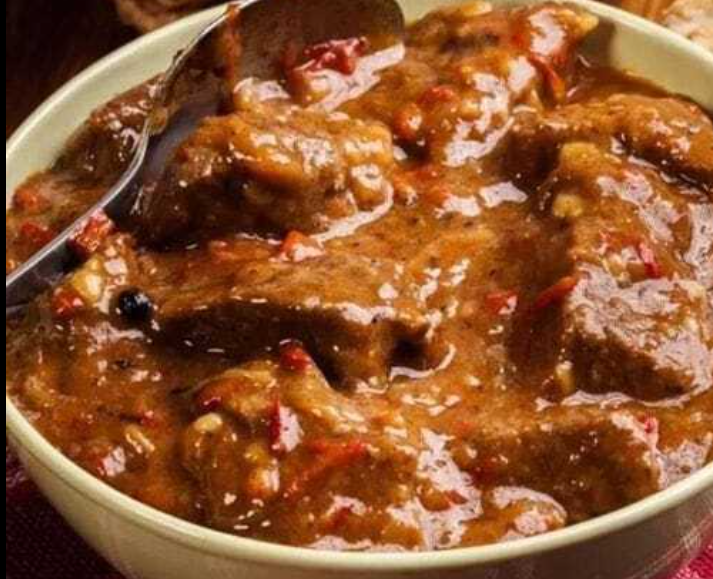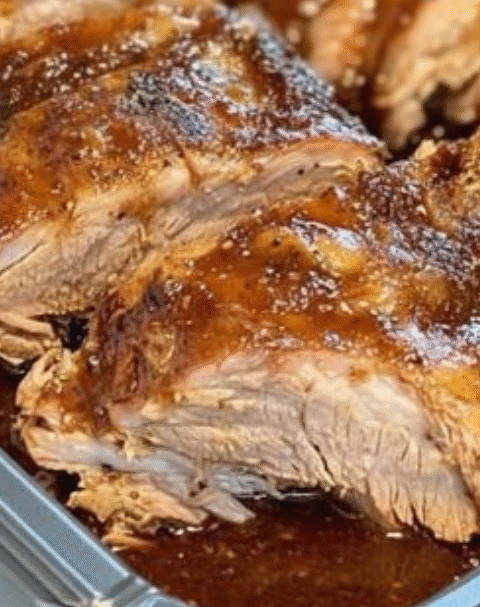Old‑Fashioned Beef Stew: A Classic Comfort Food 🥘
When you want that warm‑in‑the‑kitchen, hug‑in‑a‑bowl kind of meal, this Old‑Fashioned Beef Stew hits the spot. Hearty chunks of beef, tender potatoes and carrots, simmered in savory beef broth with aromatic rosemary and optional fresh corn, beans or turnip for extra texture. Serve it hot with crusty bread and you’ve got a meal that celebrates comfort.
Introduction
There’s something timeless about a beef stew that’s been browned, deglazed, simmered low and slow, and filled with root vegetables. Whether it’s a cold evening or you just want something satisfying, this stew delivers. In this article, you’ll get the full ingredient list and step‑by‑step instructions, chef tips, health & safety notes, a nutrition/benefit table, FAQs, and internal links for more hearty‑meal inspiration on www.freshtonerhungar.com.
Ingredients
- Olive oil — 2 tablespoons
- Cubed beef stew meat — 2 pounds
- All‑purpose flour — 2 tablespoons
- Water — 4 cups
- Beef broth — 2 cups
- Salt — 1 ½ teaspoons
- Ground black pepper — 1 ½ teaspoons
- Cubed potatoes — 4 cups
- Chopped carrots — 2 cups
- Dried rosemary — 1 teaspoon
- Optional: Fresh corn kernels — 1 cup
- Optional: Fresh green beans (cut into 1‑inch pieces) — 1 cup
- Optional: Chopped turnip — 1 cup
- Optional: Chopped fresh tomatoes — 2 cups
Why These Ingredients?
Starting with olive oil gives you a good base for browning the beef. The flour helps to lightly coat the beef pieces and will aid in thickening the stew. The water and beef broth form your simmering liquid—rich and comforting. Salt and pepper for proper seasoning. Potatoes and carrots are classic stew vegetables—they hold up to long simmering and soak up flavour. Rosemary adds herbaceous depth and a traditional note. The optional veggies (corn, green beans, turnip, tomatoes) let you tailor the stew to what you have or want—adding freshness, colour or extra texture.
Instructions
- Brown the Beef for Rich Flavor: Heat the olive oil in a large pot or Dutch oven over medium‑high heat. Pat the cubed beef dry with paper towels. In a bowl, toss the beef with the flour, salt, and pepper. Sear the beef in the hot oil until browned on all sides. Brown the meat in batches if necessary to avoid overcrowding, which ensures a proper golden crust.
- Building the Savory Broth: Once the beef is browned, pour in the water and beef broth. Use a wooden spoon to scrape up any browned bits from the bottom of the pot (that’s flavour!). Bring the broth to a boil, then reduce heat to low and simmer for 30 minutes.
- Adding the Hearty Vegetables: Add the cubed potatoes, chopped carrots, and dried rosemary to the pot. If using chopped turnip or fresh tomatoes, add them now. Increase the heat to medium‑low and simmer for about 30 minutes, or until the potatoes and carrots are tender.
- Freshness Burst (Optional): If you’re adding fresh corn kernels and green beans, add them in the last 10 minutes of cooking so they stay bright and retain some texture.
- Simmering for Perfection: Continue simmering the stew over low heat for an additional 30–60 minutes, or until the beef is fork‑tender and the vegetables are cooked through.
- Seasoning and Enjoying: Taste the stew and adjust the seasoning with additional salt and pepper if needed. Serve the old‑fashioned beef stew hot, spooned into bowls, with crusty bread on the side for dipping.
Chef Pro Tip
“Don’t rush the browning stage—it’s where the foundation of flavour is built. Also, when simmering the meat and vegetables, keep it gentle (not a hard boil) so the beef remains tender and the broth develops depth.” (Inspired by tips from seasoned stew‑recipe sources) :contentReference[oaicite:0]{index=0}
Health & Safety Considerations
- Ensure proper meat browning: Pat beef pieces dry to allow better browning (moisture on the surface will prevent proper sear). :contentReference[oaicite:1]{index=1}
- Simmer gently: A vigorous boil can make meat tough—low and slow is better for tenderness. :contentReference[oaicite:2]{index=2}
- Handle hot liquids with care: When adding broth and water, ensure pot is stable and use long‑handled spoon to scrape bottom to avoid steam burns.
- Check meat doneness: The beef should be fork‑tender. If still tough after the recommended time, continue simmering. Many stew recipes emphasise this. :contentReference[oaicite:3]{index=3}
- Proper storage: Allow stew to cool slightly before refrigerating. Store in airtight containers and consume within a safe timeframe (typically 3‑4 days) or freeze for longer. :contentReference[oaicite:4]{index=4}
Nutrition & Health Benefits Table
| Component | Approximate Quantity | Key Nutrients & Health Benefits |
|---|---|---|
| Beef stew meat (2 lbs ≈ 907 g) | ~907 g | High‑quality protein, iron, zinc and B‑vitamins—supports muscle repair and immune health. |
| Potatoes (4 cups ≈ ~600 g) | ~600 g | Provides complex carbohydrates, potassium, vitamin C (especially if skins are included) and fibre. |
| Carrots (2 cups ≈ ~240 g) | ~240 g | Rich in beta‑carotene (vitamin A precursor), fibre, and adds colour and sweetness. |
| Olive oil (2 Tbsp ≈ 30 ml) | ~30 ml | Contains heart‑healthy monounsaturated fats and aids absorption of fat‑soluble vitamins. |
| Broth + water (6 cups total ≈ 1.4 L) | ~1.4 L | Keeps the stew hydrated; if low sodium broth is used, helps control salt intake. |
Note: This is a hearty and rich stew—portion size and balancing with vegetables or salad is recommended for well‑rounded meals.
Why This Recipe Works
This recipe works because it follows the key steps many top stew‑makers highlight: searing the beef to build flavour, deglazing to pick up those browned bits, simmering slowly so the connective tissues in the meat break down and become tender rather than chewy. According to culinary experts, “low and slow” cooking and good initial browning are the secret to perfectly tender beef stew. :contentReference[oaicite:5]{index=5}
In addition, by adding vegetables in stages (root veggies early, more delicate ones later) you maintain texture and prevent over‑cooking. The addition of optional items like turnip, fresh tomatoes, corn and green beans gives flexibility to adapt this timeless dish to what you have or prefer.
Variations & Serving Suggestions
• **Vegetable swaps/Additions:** Replace or add parsnips, celery, mushrooms or peas. Some recipes recommend adding peas near the end for colour and freshness. :contentReference[oaicite:6]{index=6}
• **Thickening options:** If you prefer a thicker gravy‑like stew, you can stir a little flour or cornstarch slurry at the end. Many stew recipes include this option. :contentReference[oaicite:7]{index=7}
• **Flavor boost:** Add a splash of red wine or tomato paste at the base of the broth for extra depth of flavour. :contentReference[oaicite:8]{index=8}
• **Serving ideas:** Serve the stew with crusty bread, buttered biscuits, or over mashed potatoes or rice. A fresh green salad or steamed greens pairs well to lighten the meal.
• **Make‑ahead & leftovers:** This stew very often tastes even better the next day as flavours meld. Store leftovers in the fridge or freeze for later. :contentReference[oaicite:9]{index=9}
For more comforting one‑pot meals, browse our article on hearty dinner casseroles and slow‑simmered stews at www.freshtonerhungar.com.
10 Frequently Asked Questions (FAQs)
- Can I use a different cut of beef instead of stew meat?
Yes. You can use a chuck roast or other well‑marbled tougher cuts. The key is to cut them into uniform cubes and cook slowly so they become tender. :contentReference[oaicite:10]{index=10} - Do I really need to brown the beef?
Yes—browning creates flavour, and removes moisture from the surface so the meat sears instead of steams. Many stew‑recipes emphasise this. :contentReference[oaicite:11]{index=11} - Why are my potatoes falling apart?
If potatoes are cut too small or added too early, they may overcook and disintegrate. Use uniform size and add them with enough simmer time remaining. Optionally add delicate veggies later. - Can I make this stew in the slow cooker?
Yes—after browning the meat you can transfer everything to a slow cooker and cook on low for several hours until beef is tender. Many sources confirm this method. :contentReference[oaicite:12]{index=12} - How do I thicken the stew?
You can use a flour‑coated beef piece (as used here), or at the end stir in a cornstarch or flour slurry to reach your desired consistency. The vegetables themselves (potatoes) contribute to natural thickening. :contentReference[oaicite:13]{index=13} - Is it better the next day?
Yes—flavours often deepen and meld overnight, making leftover stew even better. :contentReference[oaicite:14]{index=14} - How should I store leftovers?
Cool the stew, transfer to airtight containers, refrigerate for 3‑4 days or freeze for up to 3 months. Reheat gently, adding a splash of broth if thickened too much. :contentReference[oaicite:15]{index=15} - Can I omit the optional vegetables?
Yes—you can keep it simple with potatoes, carrots and beef. The optional vegetables (corn, green beans, turnip, tomatoes) add variety and colour but are not essential. - What seasoning variations can I try?
You might add bay leaves, thyme sprigs, a touch of tomato paste or even red wine to deepen flavour. Many stew recipes recommend herbs and extra savoury components. :contentReference[oaicite:16]{index=16} - What side dishes go best with beef stew?
Crusty bread, biscuits, mashed potatoes, rice or a side of green salad all work well. Stew is hearty on its own but a fresh or crunchy side balances the richness.
Conclusion
This Old‑Fashioned Beef Stew brings together comfort, flavour and tradition. With browned beef, hearty vegetables, savoury broth and optional fresh additions, it’s the kind of dish you’ll want to make again and again—especially when you want something warm and satisfying. With the instructions, tips, variations and FAQs above, you’re well‑equipped to create this classic. For more hearty meals and comfort‑food favourites, explore the other recipes on www.freshtonerhungar.com. Enjoy every spoonful of this timeless stew! 🍲






